A Dynamic-Routing Algorithm Based on a Virtual Quantum Key Distribution Network
Abstract
1. Introduction
2. Technical Foundation
2.1. QKD Network Framework Based on SDN
2.2. Relay-Based Networks
2.3. Design of QKP
2.3.1. Definition of Parameters
2.3.2. Design Steps
- a.
- Quantum key sending and receiving device: responsible for generating and sending quantum keys and receiving and measuring keys sent from other devices.
- b.
- The key storage device: responsible for storing the distributed quantum keys for subsequent use.
- c.
- Quantum encryption application: uses the generated and stored keys to encrypt and decrypt the information to be transmitted. In this system, the QKP is deployed inside two communication nodes, and both relaying and encryption processing are implemented through a key control server that increases or decreases the capacity of the QKP according to the amount of service demand.
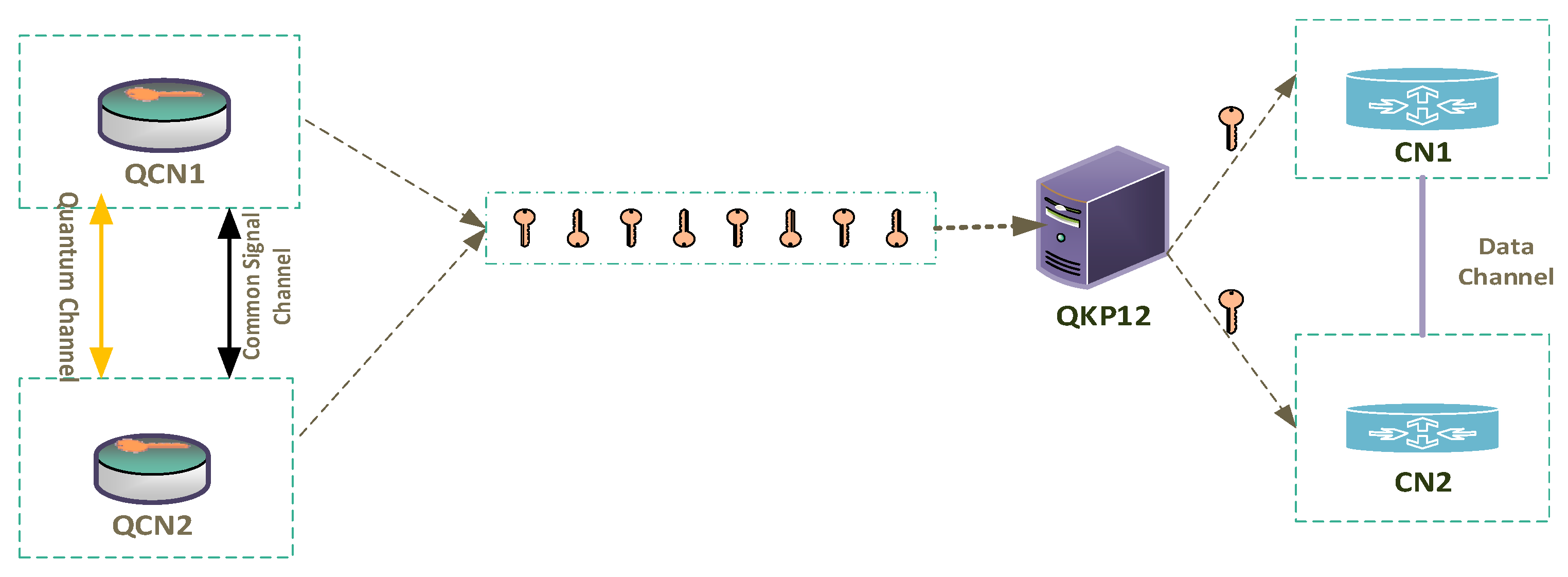
2.3.3. Remaining Key Volume
2.4. Blocking Probabilities and Thresholds
3. Routing Algorithms
3.1. Related Definitions
- 1.
- At initial time , the algorithm obtains the current network state , including the remaining quantum key amount of each node and the blocking probability of the link.
- 2.
- The algorithm uses the value function to calculate the corresponding expected payoff of each possible operation, that is, through the iterative calculation of all possible operations .
- 3.
- The algorithm selects the operation with the maximum expected payoff and updates the network state to the state in the next moment.
- 4.
- Repeat steps 2 and 3 until the algorithm converges or reaches the specified number of iterations.
3.2. Routing Algorithm Design
3.3. Algorithm Evaluation Indicators
- (1)
- Average key utilization. Average critical consumption refers to the resource consumption required to establish and maintain a security key in a dynamic QKD routing method. Dynamic QKD routing methods can utilize resources more efficiently and achieve better system performance by reducing the average key consumption. It reflects the degree to which the allocated vital resources are used within a certain period and then reflects whether the allocation and management of the key are reasonable. The calculation representation is shown in Formula (15):
- (2)
- Blocking rate of key distribution operations. The key distribution blocking rate is the probability of key distribution failure due to channel conditions, network congestion, or other factors in a dynamic QKD routing method. The blocking rate of key distribution directly affects the system availability and the efficiency of key generation. By reducing the blocking rate of key distribution, the dynamic QKD routing method can improve the success rate of key generation, effectively reduce the risk of system interruption, and improve the efficiency of key generation. The key distribution blocking probability can directly reflect the blocking situation and the system performance and is an important index to measure the performance of the QKD system. Assuming the number of blocking service interruptions occurring due to insufficient collection link resources, and denote the total number of service requests. Then, the blocking rate M of the key distribution service is obtained, where the calculation is expressed as follows (16):
- (3)
- Time delay of the algorithm. The algorithm time delay refers to the time required to compute the optimal routing and key distribution path in the dynamic QKD routing method. This index reflects the response speed and real-time performance of the dynamic QKD routing method. The lower algorithm time delay can enable the dynamic QKD routing method to adapt faster to changes in network topology and alterations in key distribution requirements, thus improving the flexibility and efficiency of the system. In QKD networks, transmission, processing, and waiting delays are usually combined into a total delay. Assuming that the routing algorithm sends data from the source node to the destination node through n intermediate nodes, the total delay of this route is as shown in (17). The average delay per link is (18):where represents the transmission time between node i and node i+1, represents the time node i caches, forwards and processes data, and represents the time node i waiting for responses from other nodes. n+1 includes the source and destination nodes. Assuming there are links on a path, means the average delay of each link.
4. Experiments
4.1. Simulation Environment Configuration
4.2. Simulation Results and Analysis
- (1)
- Comparison of average usage of key resources
- (2)
- Key distribution blocking probabilities
- (3)
- Delay comparison
5. Conclusions
Author Contributions
Funding
Institutional Review Board Statement
Informed Consent Statement
Data Availability Statement
Conflicts of Interest
References
- Tsai, C.-W.; Yang, C.-W.; Lin, J.; Chang, Y.-C.; Chang, R.-S. Quantum Key Distribution Networks: Challenges and Future Research Issues in Security. Appl. Sci. 2021, 11, 3767. [Google Scholar] [CrossRef]
- Diamanti, E.; Lo, H.K.; Qi, B.; Yuan, Z. Practical challenges in quantum key distribution. Npj Quantum Inf. 2016, 2, 16025. [Google Scholar] [CrossRef]
- Bencheikh, K.; Symul, T.; Jankovic, A.; Levenson, J.A. Quantum key distribution with continuous variables. J. Mod. Opt. 2001, 48, 1903–1920. [Google Scholar] [CrossRef]
- Dong, H.; Song, Y.; Yang, L. Wide Area Key Distribution Network Based on a Quantum Key Distribution System. Appl. Sci. 2019, 9, 1073. [Google Scholar] [CrossRef]
- Chatterjee, S.; Goswami, K.; Chatterjee, R.; Sinha, U. Polarization bases compensation towards advantages in satellite-based QKD without active feedback. Commun. Phys. 2023, 6, 116. [Google Scholar] [CrossRef]
- Song, T.T.; Qin, S.J.; Wen, Q.Y.; Wang, Y.K.; Jia, H.Y. Finite-key security analyses on passive decoy-state QKD protocols with different unstable sources. Sci. Rep. 2015, 5, 15276. [Google Scholar] [CrossRef]
- Beutel, F.; Gehring, H.; Wolff, M.A.; Schuck, C.; Pernice, W. Detector-integrated on-chip QKD receiver for GHz clock rates. Npj Quantum Inf. 2021, 7, 40. [Google Scholar] [CrossRef]
- Chen, L.Q.; Chen, J.Q.; Chen, Q.Y.; Zhao, Y.L. A quantum key distribution routing scheme for hybrid-trusted QKD network system. Quantum Inf. Process 2023, 22, 75. [Google Scholar] [CrossRef]
- Xuan, W. Research on Dynamic Routing and Application Access of Quantum Secure Communication Network; Xidian University: Xi’an, China, 2014. [Google Scholar]
- Han, Q.; Yu, L.; Zheng, W.; Cheng, N.; Niu, X. A novel QKD network routing algorithm based on optical-path-switching. J. Inf. Hiding Multimed. Signal Process. 2014, 5, 13–19. [Google Scholar]
- Ma, C.; Guo, Y.; Su, J.; Yang, C. Hierarchical routing scheme on wide-area quantum key distribution network. In Proceedings of the 2016 2nd IEEE International Conference on Computer and Communications (ICCC), Chengdu, China, 14–17 October 2016; pp. 2009–2014. [Google Scholar]
- Tanizawa, Y.; Takahashi, R.; Dixon, A.R. A routing method designed for a Quantum Key Distribution network. In Proceedings of the 2016 Eighth International Conference on Ubiquitous and Future Networks (ICUFN), Vienna, Austria, 5–8 July 2016; pp. 208–214. [Google Scholar]
- Yan, J.; Zhang, Y.; Li, H.; Yang, Y.; Zheng, D. An Improved Quantum Key Distribution Routing Algorithm Based on Reinforcement Learning. IEEE Access 2020, 8, 87277–87285. [Google Scholar]
- Zhu, Q.; Yu, X.; Zhao, Y.; Nag, A.; Zhang, J. Resource Allocation in Quantum-Key-Distribution- Secured Datacenter Networks With Cloud–Edge Collaboration. IEEE Internet Things J. 2023, 10, 10916–10932. [Google Scholar] [CrossRef]
- Scarani, V.; Bechmann-Pasquinucci, H.; Cerf, N.J.; Dušek, M.; Lütkenhaus, N.; Peev, M. The security of practical quantum key distribution. Rev. Mod. Phys. 2009, 81, 1301. [Google Scholar] [CrossRef]
- Wang, H.; Zhao, Y.; Nag, A. Quantum-Key-Distribution (QKD) Networks Enabled by Software-Defined Networks (SDN). Appl. Sci. 2019, 9, 2081. [Google Scholar] [CrossRef]
- Aguado, A.; López, V.; Brito, J.P.; Pastor, A.; López, D.R.; Martin, V. Enabling Quantum Key Distribution Networks via Software-Defined Networking. In Proceedings of the 2020 International Conference on Optical Network Design and Modeling (ONDM), Barcelona, Spain, 18–21 May 2020. [Google Scholar]
- Cao, Y.; Zhao, Y.; Yu, X.; Zhang, J. Multi-tenant provisioning over software defined networking enabled metropolitan area quantum key distribution networks. JOSA B 2019, 36, B31–B40. [Google Scholar] [CrossRef]
- Lopez, V.; Pastor, A.; Lopez, D.; Aguado, A.; Martin, V. Applying QKD to improve next-generation network infrastructures. In Proceedings of the 2019 European Conference on Networks and Communications (EuCNC), Valencia, Spain, 18–21 June 2019; pp. 283–288. [Google Scholar]
- Tang, Z.; Zhang, P.; Krawec, W.O. Enabling Resilient Quantum-Secured Microgrids Through Software-Defined Networking. IEEE Trans. Quantum Eng. 2022, 3, 4100811. [Google Scholar] [CrossRef]
- Cao, Y.; Zhao, Y.; Wang, J.; Yu, X.; Ma, Z.; Zhang, J. KaaS: Key as a Service over Quantum Key Distribution Integrated Optical Networks. IEEE Commun. Mag. 2019, 57, 152–159. [Google Scholar] [CrossRef]
- Boyer, M.; Liss, R.; Mor, T. Composable Security of Generalized BB84 Protocols Against General Attacks. arXiv 2022, arXiv:2208.12154. [Google Scholar]
- Winiarczyk, P.; Zabierowski, W. BB84 analysis of operation and practical considerations and implementations of quantum key distribution systems. In Proceedings of the 2011 11th International Conference the Experience of Designing and Application of CAD Systems in Microelectronics (CADSM), Polyana, Ukraine, 23–25 February 2011; pp. 23–26. [Google Scholar]
- Hong, C.H.; Heo, J.; Jang, J.G.; Kwon, D. Quantum identity authentication with single photon. Quantum Inf. Process. 2017, 16, 236. [Google Scholar] [CrossRef]
- Oliveira, R.D.; Arabul, E.; Wang, R.; Vrontos, C.; Nejabati, R.; Simeonidou, D. Programmable, Latency-Aware and Dynamic Quantum-Secured Optical Network with Key Refresh Rate Negotiation and QKD Sharing. In Proceedings of the 2023 Optical Fiber Communications Conference and Exhibition (OFC), San Diego, CA, USA, 5–9 March 2023; pp. 1–3. [Google Scholar]
- Sun, Y. A Differentialized Service Providing Scheme on Trusted Relay Quantum Key Distribution Networks. Acta Photonica Sin. 2014, 17, 74–78. [Google Scholar]
- Yang, C.; Zhang, H.; Su, J. Quantum key distribution network: Optimal secret-key-aware routing method for trust relaying. China Commun. 2018, 15, 33–45. [Google Scholar] [CrossRef]
- Salvail, L.; Peev, M.; Diamanti, E.; Alléaume, R.; Lütkenhaus, N.; Länger, T. Security of Trusted Repeater Quantum Key Distribution Networks. J. Comput. Secur. 2010, 18, 61–87. [Google Scholar] [CrossRef]
- Lin, X.; Hou, G.; Lin, W.; Chen, K. Quantum key distribution in partially-trusted QKD ring networks. In Proceedings of the 2020 IEEE 3rd International Conference on Information Systems and Computer Aided Education (ICISCAE), Dalian, China, 27–29 September 2020; pp. 33–36. [Google Scholar]
- Mehic, M.; Fazio, P.; Rass, S.; Maurhart, O.; Peev, M.; Poppe, A.; Rozhon, J.; Niemiec, M.; Voznak, M. A Novel Approach to Quality-of-Service Provisioning in Trusted Relay Quantum Key Distribution Networks. IEEE/ACM Trans. Netw. 2020, 28, 168–181. [Google Scholar] [CrossRef]
- Huttner, B.; Alléaume, R.; Diamanti, E.; Fröwis, F.; Grangier, P.; Hübel, H.; Martin, V.; Poppe, A.; Slater, J.A.; Spiller, T.; et al. Long-range QKD without trusted nodes is not possible with current technology. Npj Quantum Inf. 2022, 8, 108. [Google Scholar] [CrossRef]
- Cao, Y.; Zhao, Y.; Colman-Meixner, C.; Yu, X.; Zhang, J. Key on demand (KoD) for software-defined optical networks secured by quantum key distribution (QKD). Opt. Express 2017, 25, 26453–26467. [Google Scholar] [CrossRef] [PubMed]
- Lo, H.K.; Curty, M.; Tamaki, K. Secure quantum key distribution. Nat. Photon 2014, 8, 595–604. [Google Scholar] [CrossRef]
- Wang, Q.; Yu, X.; Zhu, Q.; Zhao, Y.; Zhang, J. Quantum key pool construction and key distribution scheme in multi-domain QKD optical networks (QKD-ON). In Proceedings of the 4th Optics Young Scientist Summit (OYSS 2020), Ningbo, China, 28 February 2021. [Google Scholar]
- Jia, J.; Dong, B.; Kang, L.; Xie, H.; Guo, B. Cost-Optimization-Based Quantum Key Distribution over Quantum Key Pool Optical Networks. Entropy 2023, 25, 661. [Google Scholar] [CrossRef]
- Zhang, Q.; Ayoub, O.; Gatto, A.; Wu, J.; Musumeci, F.; Tornatore, M. Routing, Channel, Key-Rate and Time-Slot Assignment for QKD in Optical Networks. IEEE Trans. Netw. Serv. Manag. 2023; early access. [Google Scholar] [CrossRef]
- Yu, X.; Ning, X.; Zhu, Q.; Lv, J.; Zhao, Y.; Zhang, H.; Zhang, J. Multi-Dimensional Routing, Wavelength, and Timeslot Allocation (RWTA) in Quantum Key Distribution Optical Networks (QKD-ON). Appl. Sci. 2020, 11, 348. [Google Scholar] [CrossRef]
- Akhtar, M.S.; Krishnakumar, G.; Vishnu, B.; Sinha, A. Fast and Secure Routing Algorithms for Quantum Key Distribution Networks. IEEE/ACM Trans. Netw. 2023; early access. [Google Scholar] [CrossRef]
- Meng, X.; Yu, X.; Chen, W.; Zhao, Y.; Zhang, J. Residual-adaptive Key Provisioning in Quantum-Key-Distribution Enhanced Internet of Things (Q-IoT). In Proceedings of the 2020 International Wireless Communications and Mobile Computing (IWCMC), Limassol, Cyprus, 15–19 June 2020; pp. 2022–2027. [Google Scholar]
- Pan, X.; Lu, Z.; Wang, W.; Hua, Z.; Xu, Y.; Li, W.; Cai, W.; Li, X.; Wang, H.; Song, Y.P.; et al. Deep quantum neural networks on a superconducting processor. Nat. Commun. 2023, 14, 4006. [Google Scholar] [CrossRef]
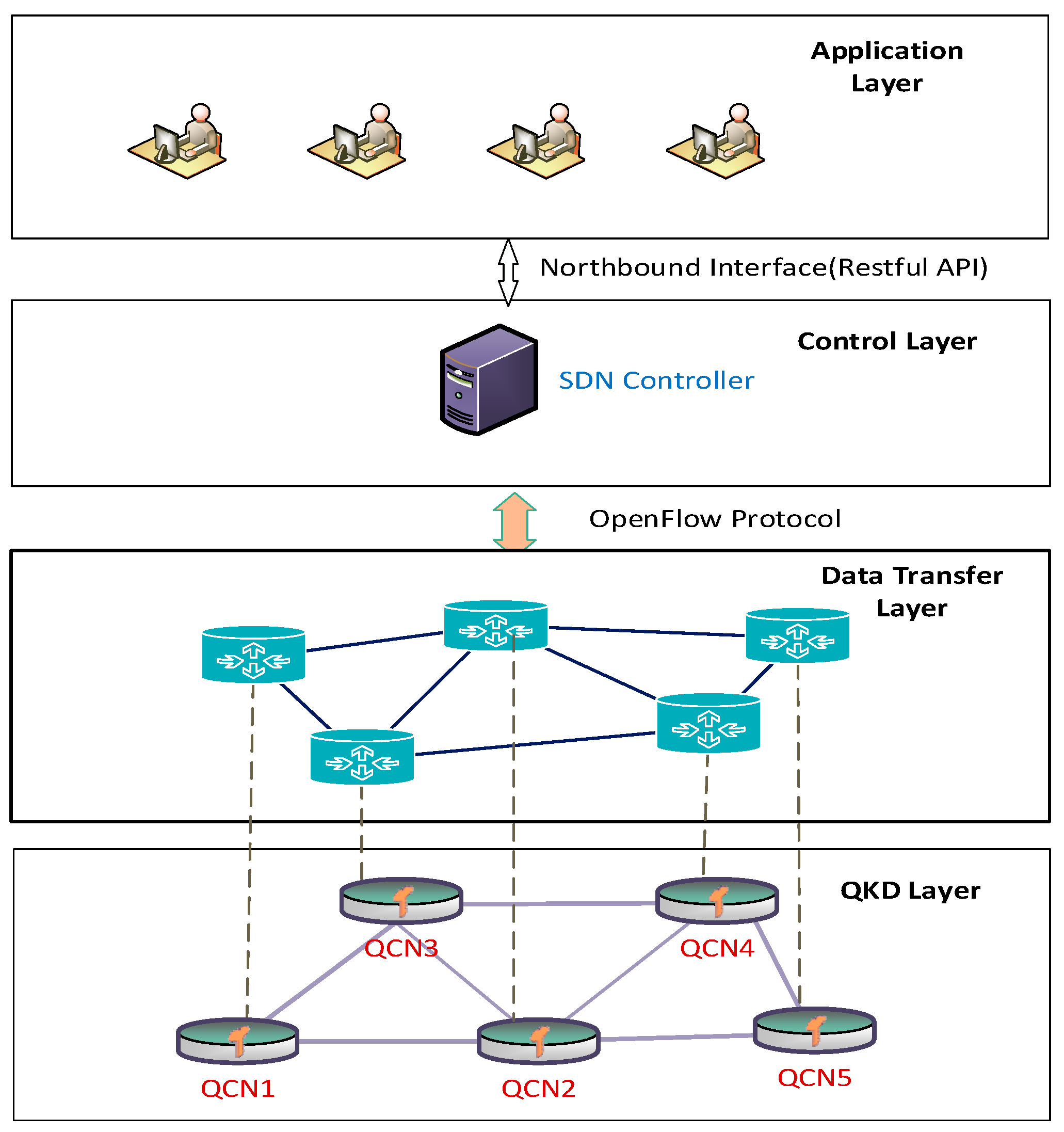
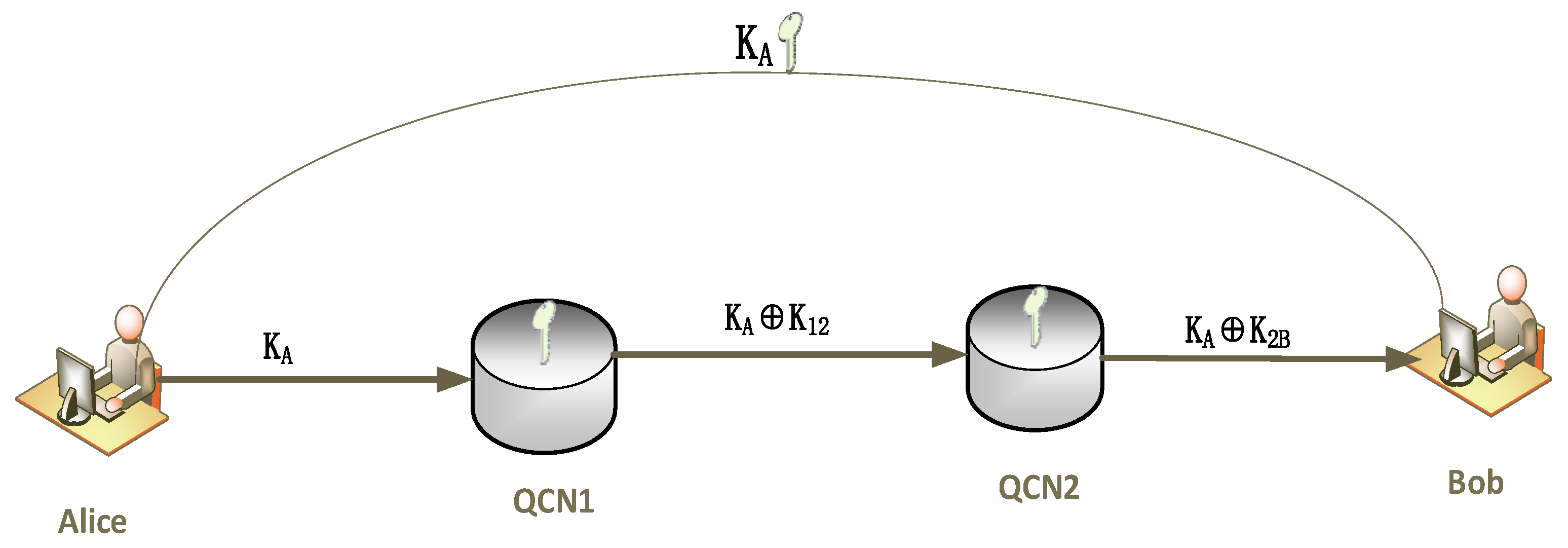
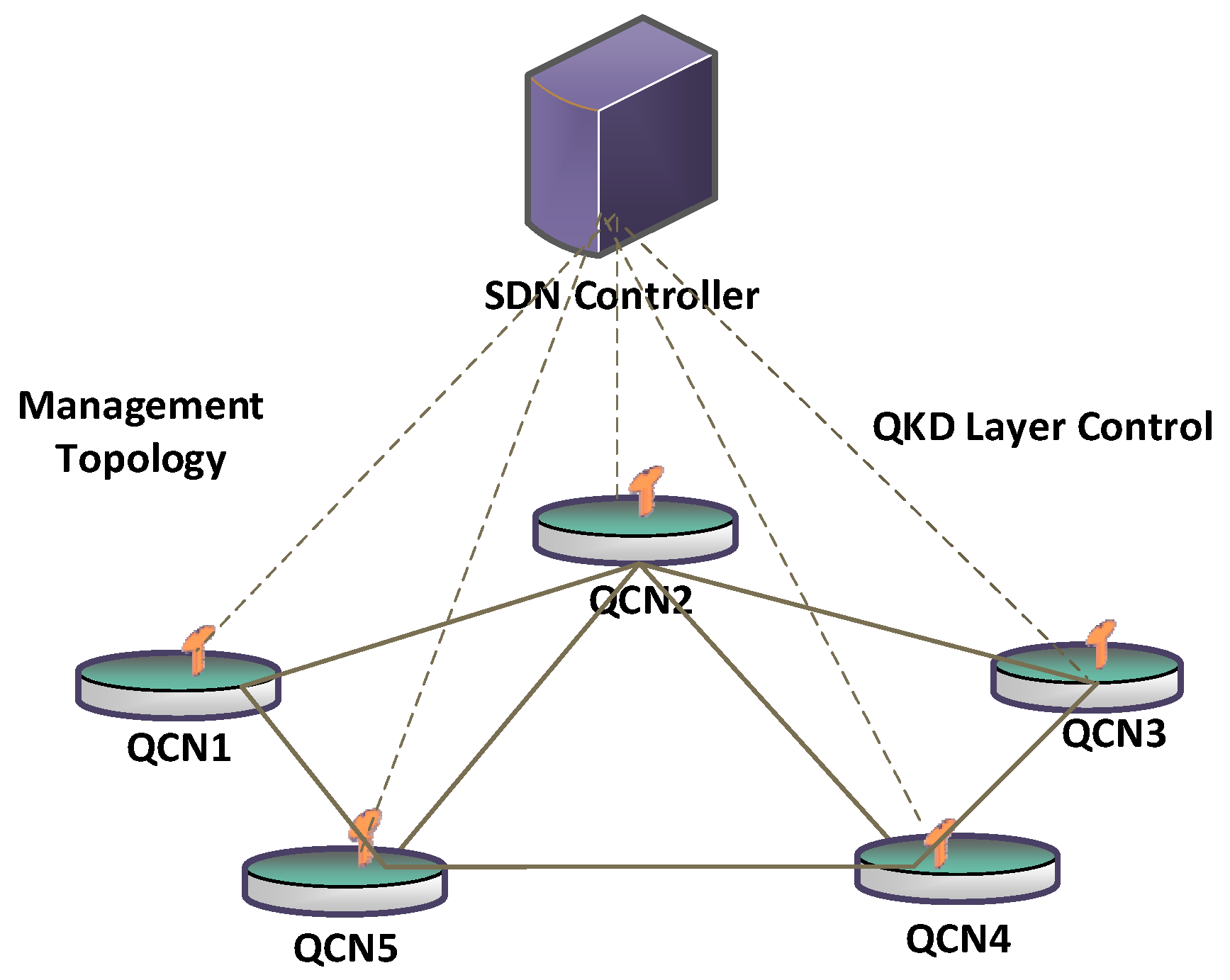
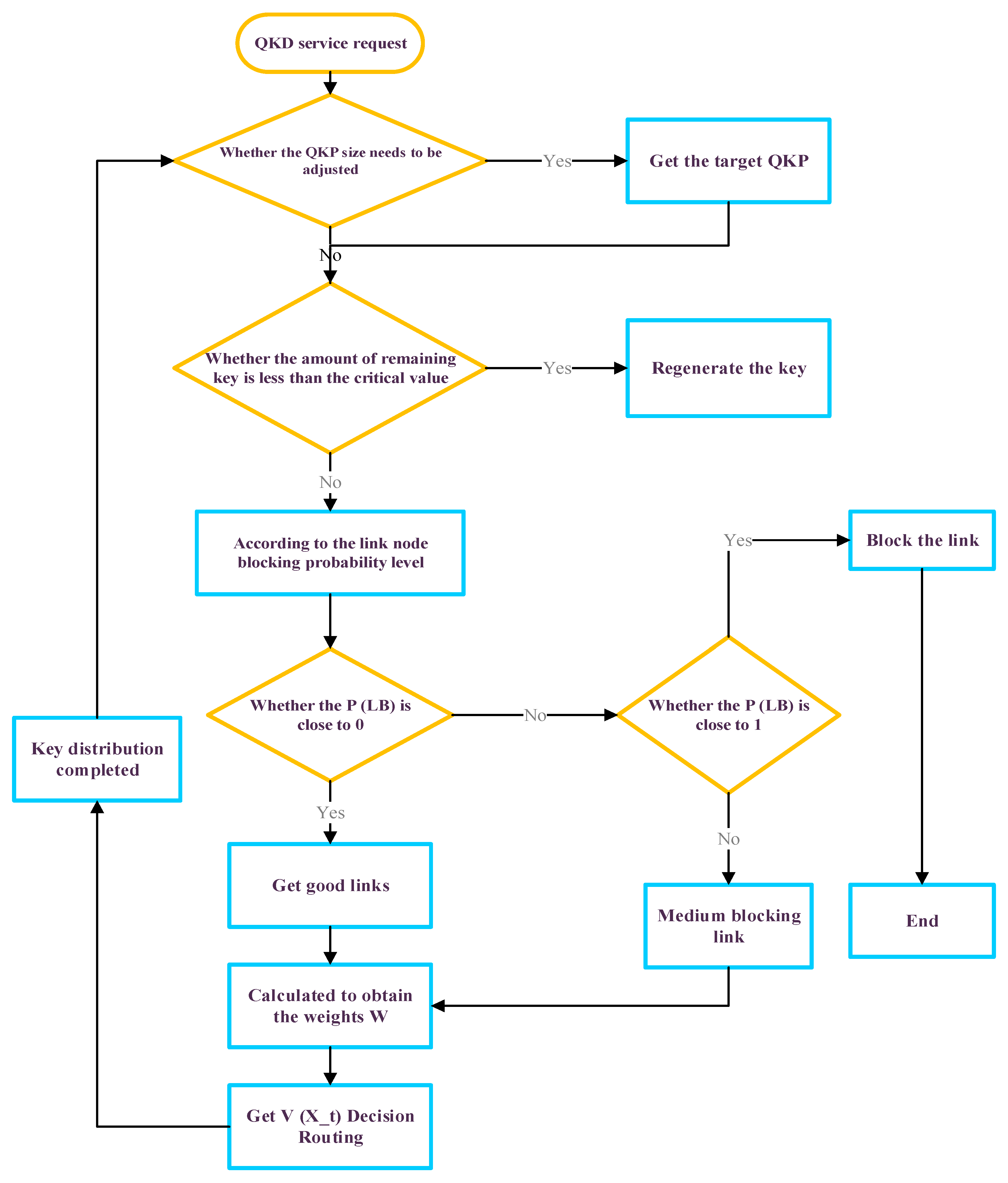
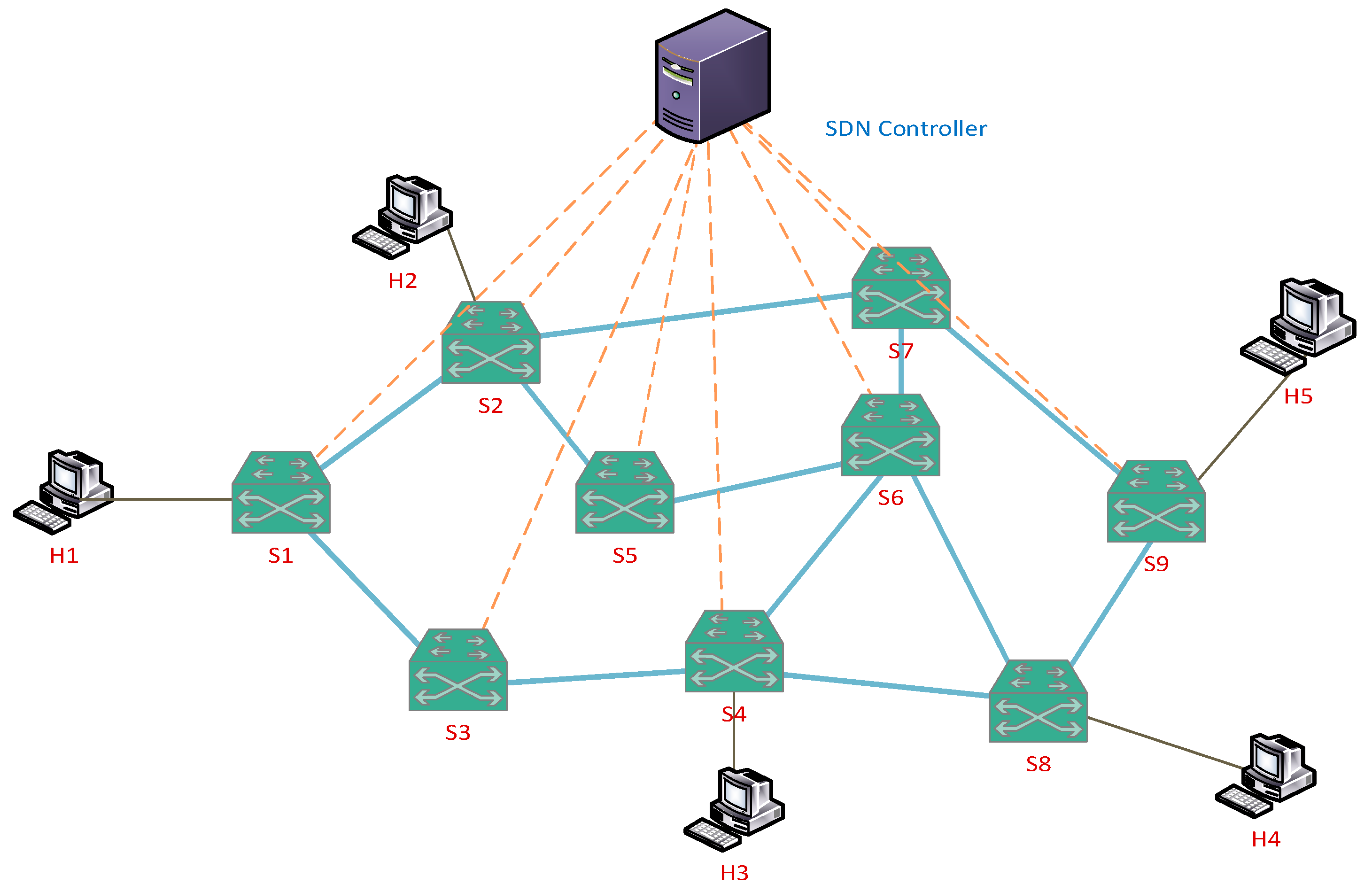
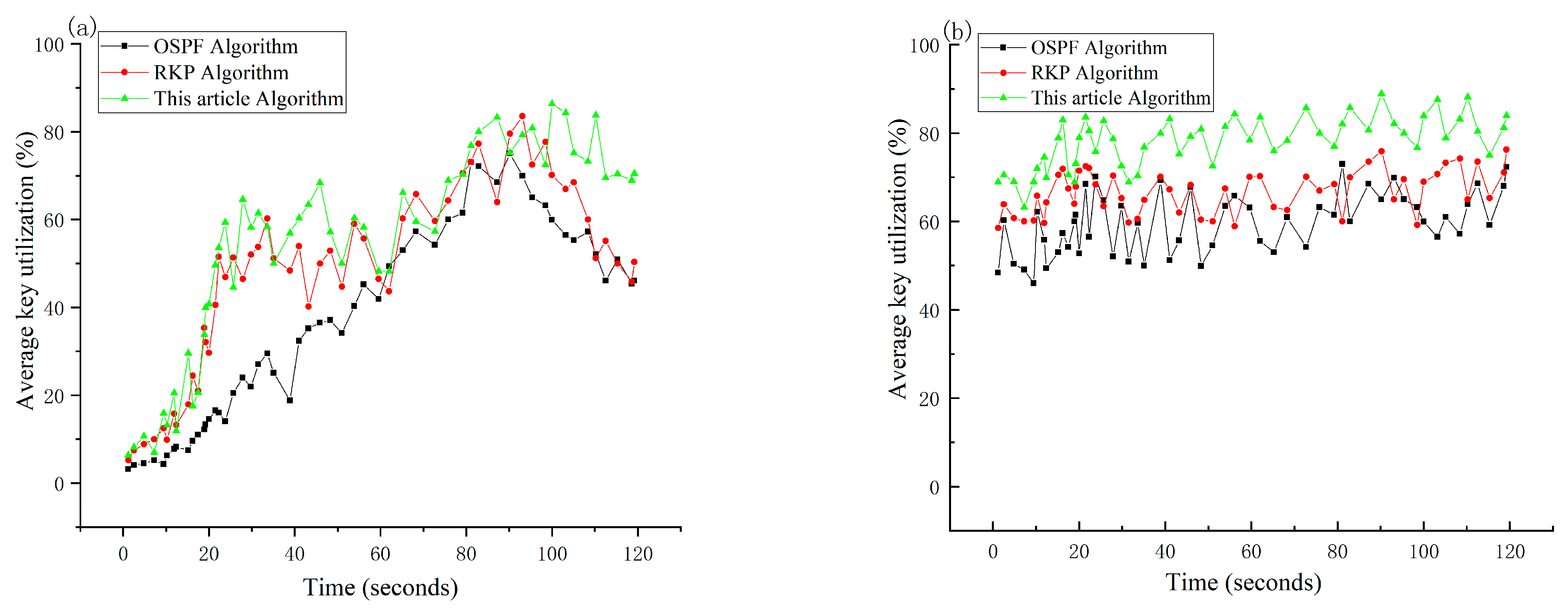
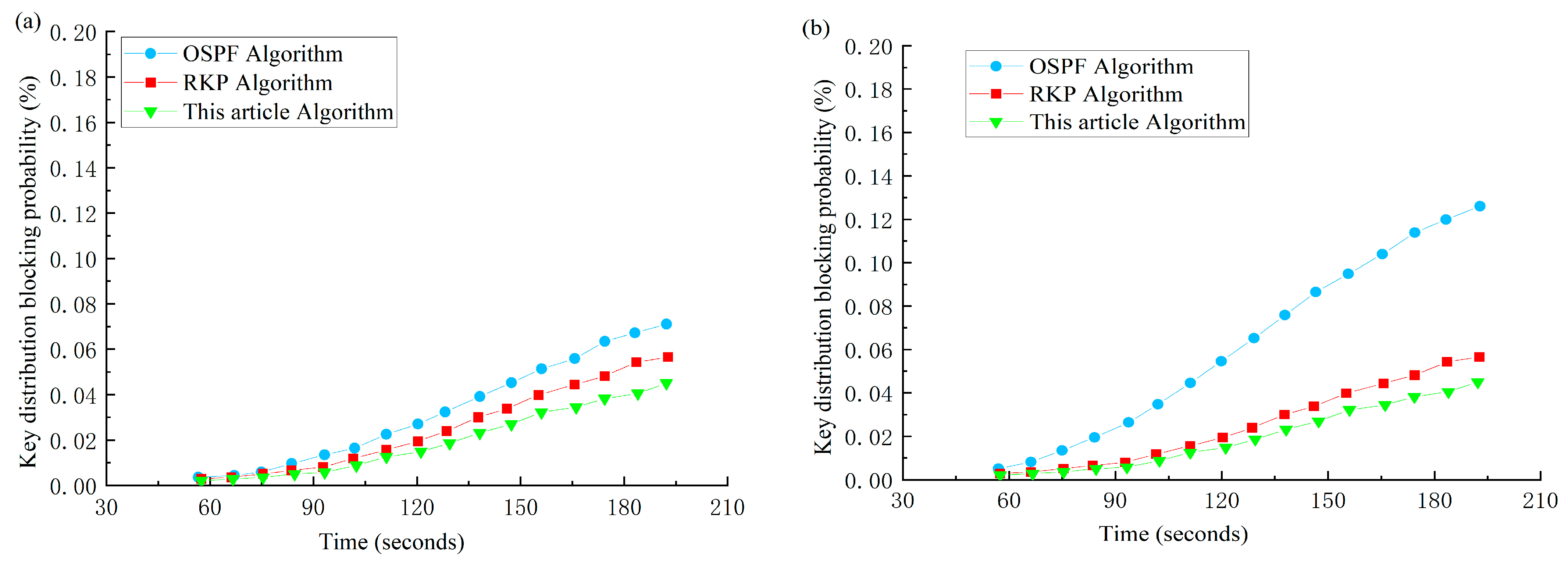
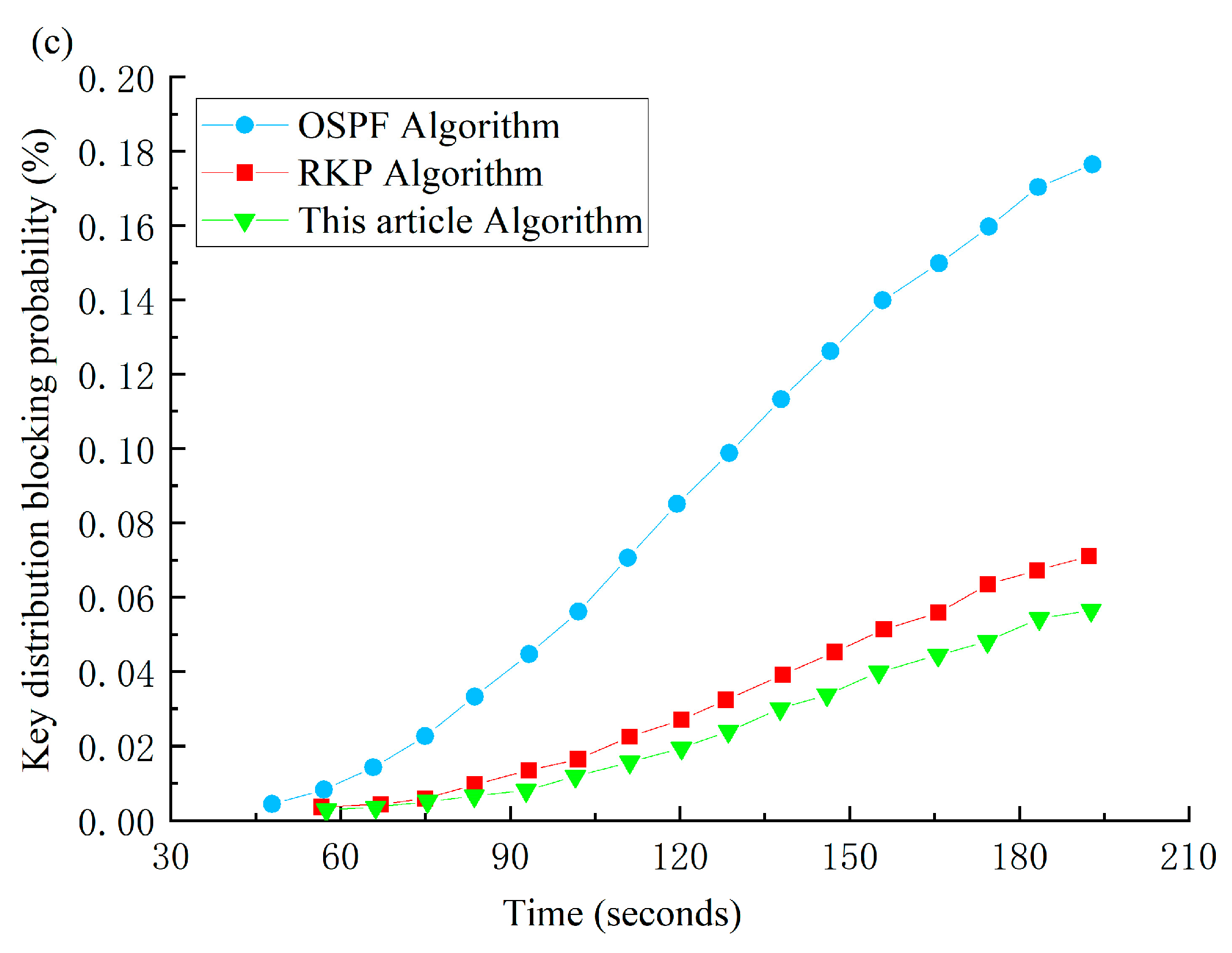

| Algorithm | Mean Value | Standard Deviation | Least Value | Maximum Value | Median |
|---|---|---|---|---|---|
| OSPF Algorithm | 35.54685 | 22.4593 | 3.2000 | 75.0000 | 35.8500 |
| RKP Algorithm | 47.38364 | 20.96505 | 5.2100 | 83.5000 | 51.19958 |
| This article Algorithm | 53.6791 | 23.25971 | 6.3400 | 86.3500 | 58.82423 |
Disclaimer/Publisher’s Note: The statements, opinions and data contained in all publications are solely those of the individual author(s) and contributor(s) and not of MDPI and/or the editor(s). MDPI and/or the editor(s) disclaim responsibility for any injury to people or property resulting from any ideas, methods, instructions or products referred to in the content. |
© 2023 by the authors. Licensee MDPI, Basel, Switzerland. This article is an open access article distributed under the terms and conditions of the Creative Commons Attribution (CC BY) license (https://creativecommons.org/licenses/by/4.0/).
Share and Cite
Bi, L.; Miao, M.; Di, X. A Dynamic-Routing Algorithm Based on a Virtual Quantum Key Distribution Network. Appl. Sci. 2023, 13, 8690. https://doi.org/10.3390/app13158690
Bi L, Miao M, Di X. A Dynamic-Routing Algorithm Based on a Virtual Quantum Key Distribution Network. Applied Sciences. 2023; 13(15):8690. https://doi.org/10.3390/app13158690
Chicago/Turabian StyleBi, Lin, Minghui Miao, and Xiaoqiang Di. 2023. "A Dynamic-Routing Algorithm Based on a Virtual Quantum Key Distribution Network" Applied Sciences 13, no. 15: 8690. https://doi.org/10.3390/app13158690
APA StyleBi, L., Miao, M., & Di, X. (2023). A Dynamic-Routing Algorithm Based on a Virtual Quantum Key Distribution Network. Applied Sciences, 13(15), 8690. https://doi.org/10.3390/app13158690





